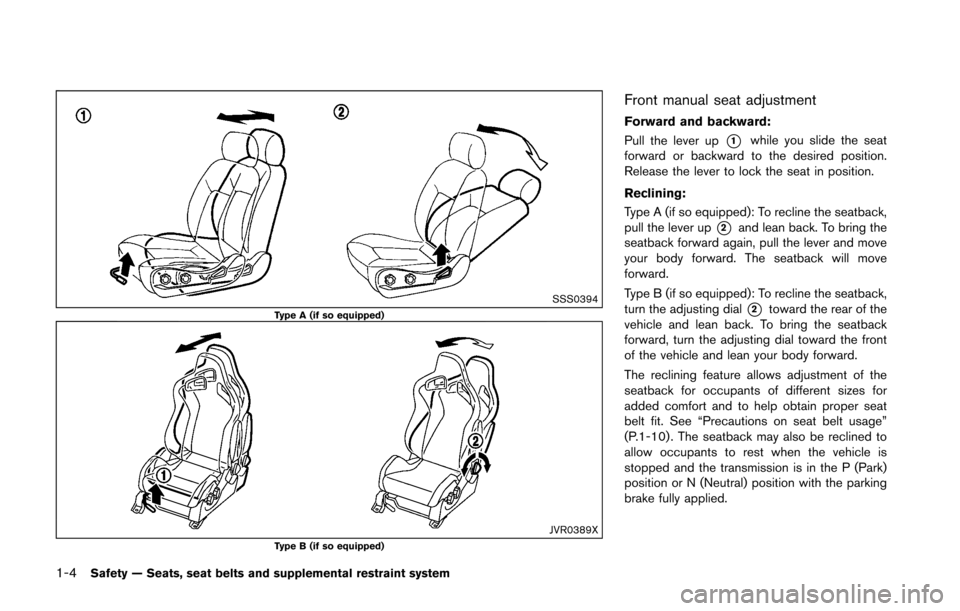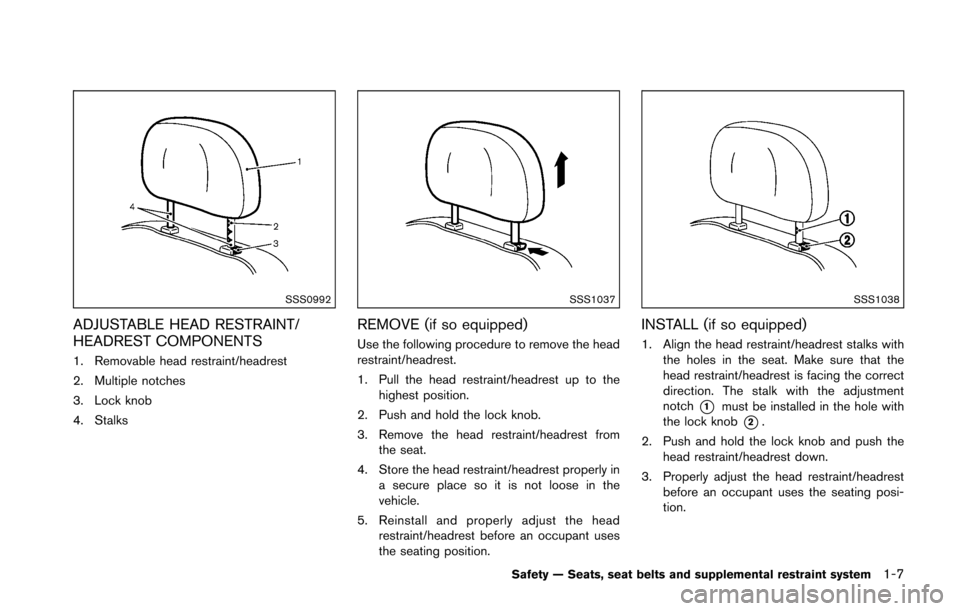Page 13 of 428
0-4Illustrated table of contents
JVC0287X
1. Hood (P.3-16)
2. Headlight and turn signal— Operation (P.2-33)
— Bulb replacement (P.8-26)
3. Windshield wiper and washer — Operation (P.2-31)
— Maintenance (P.8-20) 4. Power windows (P.2-45)
5. Outside mirrors (P.3-38)
6. Recovery hook (P.6-21)
7. License plate installation (P.9-14)
8. Daytime running light
— Operation (P.2-33)
— Bulb replacement (P.8-26) 9. Tires
— Wheels and tires (P.8-30, P.9-9)
— Flat tire (P.6-3)
— Tire Pressure Monitoring System (TPMS)
(P.2-13, P.5-3)
10. Side turn signal light (if so equipped) — Operation (P.2-33)
— Bulb replacement (P.8-26)
11. Doors — Keys (P.3-2)
— Door locks (P.3-4)
— Intelligent Key system (P.3-6)
— Remote keyless entry system (P.3-13)
EXTERIOR FRONT
Page 21 of 428
0-12Illustrated table of contents
SSI0509
1. ENTER/NEXT switch (P.2-23)
2. Fuel gauge (P.2-8)
3. Warning/Indicator lights (P.2-10)
4. Tachometer (P.2-7)
5. Speedometer (P.2-6)
6. Instrument brightness control switch (P.2-36)
7. Vehicle information display (P.2-18)8. Engine coolant temperature gauge (P.2-7)
9. Transmission position indicator (if so equipped)
(P.2-17)
— SynchroRev Match mode (S-MODE) indica-
tor (if so equipped) (P.5-17)
SSI0521
10. Odometer/Twin trip odometer control knob(P.2-6)
11. Odometer/Twin trip odometer (P.2-6)
12. Engine oil temperature gauge (P.2-8)
13. Voltmeter (P.2-9)
14. Clock (P.2-9, P.2-26)
METERS AND GAUGES
Page 23 of 428

0-14Illustrated table of contents
Warninglight Name
Page
Anti-lock Braking System
(ABS) warning light 2-11
Automatic Transmission (AT)
check warning light (if so
equipped)2-11
Brake warning light
2-11
Charge warning light2-12
Engine oil pressure warning
light2-12
Intelligent Key system warning
light
2-12
Low tire pressure warning light
2-13
Master warning light2-14
Seat belt warning light2-14
Supplemental air bag warning
light2-14
Vehicle Dynamic Control (VDC)
warning light2-15Indicator
light Name
Page
Cruise indicator light 2-15
Exterior light indicator
2-15
Front passenger air bag status
light2-15
High beam indicator light
2-15
Malfunction Indicator Light
(MIL)2-15
Rear fog light indicator light (if
so equipped)2-16
Security indicator light
2-16
Soft top indicator light (Road-
ster models)2-16
SynchroRev Match mode (S-
MODE) indicator (if so
equipped)2-17
Transmission position indicator
light (if so equipped)
2-17
Turn signal/hazard indicator
lights
2-17
Vehicle Dynamic Control (VDC)
off indicator light2-17
WARNING AND INDICATOR LIGHTS
Page 25 of 428

1-2Safety — Seats, seat belts and supplemental restraint system
SSS0133
WARNING
.Do not ride in a moving vehicle
when the seatback is reclined. This
can be dangerous. The shoulder belt
will not be against your body. In an
accident, you could be thrown into it
and receive neck or other serious
injuries. You could also slide under
the lap belt and receive serious
internal injuries.
. For the most effective protection
when the vehicle is in motion, the
seat should be upright. Always sit well back in the seat with both feet
on the floor and adjust the seat belt
properly. See “Precautions on seat
belt usage” (P.1-10) .
. After adjustment, gently rock in the
seat to make sure it is securely
locked.
. Do not leave children unattended
inside the vehicle. They could un-
knowingly activate switches or con-
trols. Unattended children could
become involved in serious acci-
dents. .
The seatback should not be reclined
any more than needed for comfort.
Seat belts are most effective when
the passenger sits well back and
straight up in the seat. If the seat-
back is reclined, the risk of sliding
under the lap belt and being injured
is increased.
CAUTION
.When adjusting the seat positions,
be sure not to contact any moving
parts to avoid possible injuries and/
or damages.
SEATS
Page 27 of 428

1-4Safety — Seats, seat belts and supplemental restraint system
SSS0394Type A (if so equipped)
JVR0389XType B (if so equipped)
Front manual seat adjustment
Forward and backward:
Pull the lever up
*1while you slide the seat
forward or backward to the desired position.
Release the lever to lock the seat in position.
Reclining:
Type A (if so equipped): To recline the seatback,
pull the lever up
*2and lean back. To bring the
seatback forward again, pull the lever and move
your body forward. The seatback will move
forward.
Type B (if so equipped): To recline the seatback,
turn the adjusting dial
*2toward the rear of the
vehicle and lean back. To bring the seatback
forward, turn the adjusting dial toward the front
of the vehicle and lean your body forward.
The reclining feature allows adjustment of the
seatback for occupants of different sizes for
added comfort and to help obtain proper seat
belt fit. See “Precautions on seat belt usage”
(P.1-10) . The seatback may also be reclined to
allow occupants to rest when the vehicle is
stopped and the transmission is in the P (Park)
position or N (Neutral) position with the parking
brake fully applied.
Page 29 of 428

1-6Safety — Seats, seat belts and supplemental restraint system
WARNING
Head restraints/headrests supplement
the other vehicle safety systems. They
may provide additional protection
against injury in certain rear end colli-
sions. Adjustable head restraints/head-
rests must be adjusted properly, as
specified in this section. Check the
adjustment after someone else uses
the seat. Do not attach anything to the
head restraint/headrest stalks or re-
move the head restraint/headrest. Do
not use the seat if the head restraint/
headrest has been removed. If the head
restraint/headrest was removed, rein-
stall and properly adjust the head
restraint/headrest before an occupant
uses the seating position. Failure to
follow these instructions can reduce the
effectiveness of the head restraint/
headrest. This may increase the risk of
serious injury or death in a collision.
SSS1007
The illustration shows the seating positions
equipped with head restraints/headrests.
Indicates the seating position is equipped
with a head restraint.
. Your vehicle is equipped with a head
restraint/headrest that may be integrated,
adjustable or non-adjustable.
. Adjustable head restraints/headrests have
multiple notches along the stalk to lock them
in a desired adjustment position.
. The non-adjustable head restraints/head-
rests have a single locking notch to secure
them to the seat frame. .
Proper Adjustment:
— For the adjustable type, align the head
restraint/headrest so the center of your
ear is approximately level with the center
of the head restraint/headrest.
— If your ear position is still higher than the recommended alignment, place the head
restraint/headrest at the highest position.
. If the head restraint/headrest has been
removed, ensure that it is reinstalled and
locked in place before riding in that desig-
nated seating position.
HEAD RESTRAINTS/HEADRESTS
Page 30 of 428

SSS0992
ADJUSTABLE HEAD RESTRAINT/
HEADREST COMPONENTS
1. Removable head restraint/headrest
2. Multiple notches
3. Lock knob
4. Stalks
SSS1037
REMOVE (if so equipped)
Use the following procedure to remove the head
restraint/headrest.
1. Pull the head restraint/headrest up to thehighest position.
2. Push and hold the lock knob.
3. Remove the head restraint/headrest from the seat.
4. Store the head restraint/headrest properly in a secure place so it is not loose in the
vehicle.
5. Reinstall and properly adjust the head restraint/headrest before an occupant uses
the seating position.
SSS1038
INSTALL (if so equipped)
1. Align the head restraint/headrest stalks withthe holes in the seat. Make sure that the
head restraint/headrest is facing the correct
direction. The stalk with the adjustment
notch
*1must be installed in the hole with
the lock knob
*2.
2. Push and hold the lock knob and push the head restraint/headrest down.
3. Properly adjust the head restraint/headrest before an occupant uses the seating posi-
tion.
Safety — Seats, seat belts and supplemental restraint system1-7
Page 31 of 428
1-8Safety — Seats, seat belts and supplemental restraint system
SSS0997
ADJUST (if so equipped)
Adjust the head restraint/headrest so the center
is level with the center of your ears. If your ear
position is still higher than the recommended
alignment, place the head restraint/headrest at
the highest position.
SSS1035
Raise
To raise the head restraint/headrest, pull it up.
Make sure the head restraint/headrest is posi-
tioned so the lock knob is engaged in the notch
before riding in that designated seating position.
SSS1036
Lower
To lower, push and hold the lock knob and push
the head restraint/headrest down.
Make sure the head restraint/headrest is posi-
tioned so the lock knob is engaged in the notch
before riding in that designated seating position.